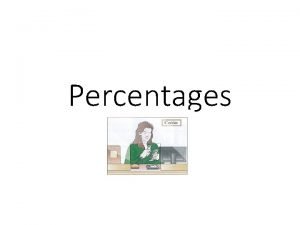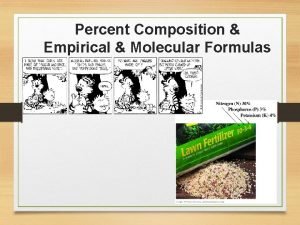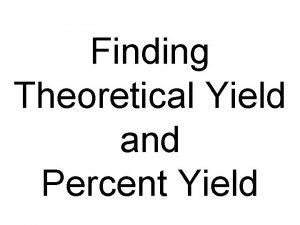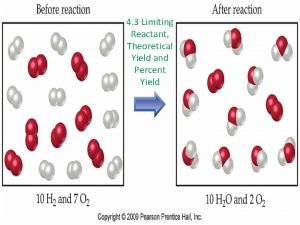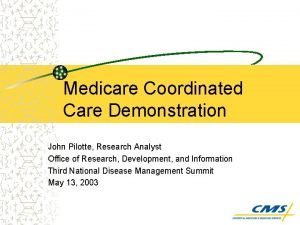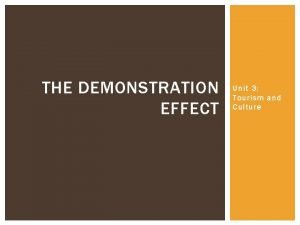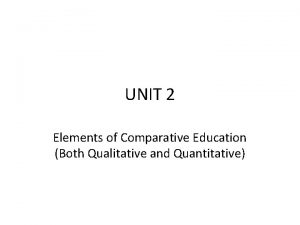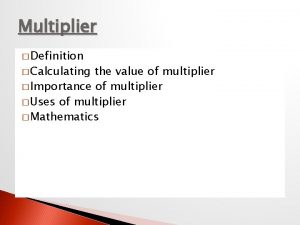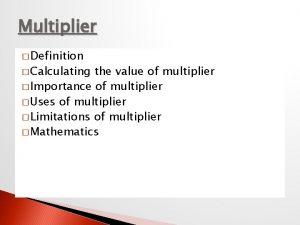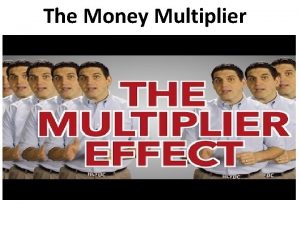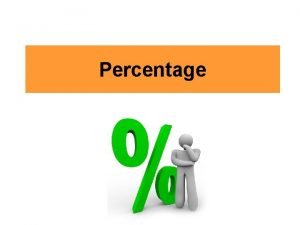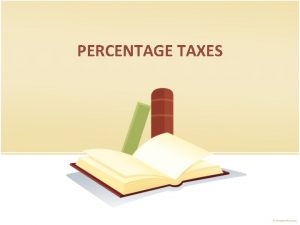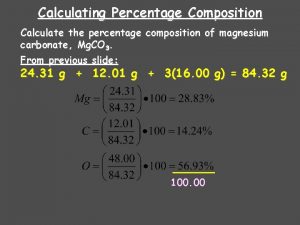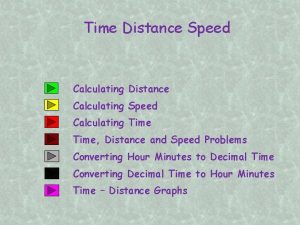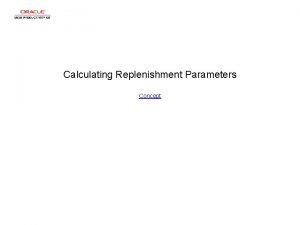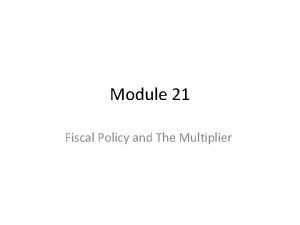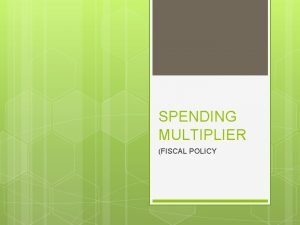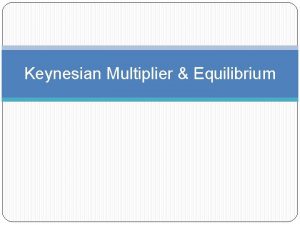Calculating a Percentage Multiplier Demonstration This resource provides





































- Slides: 37

Calculating a Percentage Multiplier – Demonstration This resource provides animated demonstrations of the mathematical method. Check animations and delete slides not needed for your class.

Using decimals to find a percentage of a quantity. 300% = 80 × 3 80 80 200% = 80 × 2 80 100% = 80 × 1 80 50% = 80 × 0. 5 40 80 80

Using decimals to find a percentage of a quantity. 100% = 90 × 1 90 50% = 90 × 0. 5 45 75% = 90 × 0. 75 67. 5 27% = 90 × 0. 27 24. 3

Use a decimal to calculate these percentages of quantities. 100% = 70 × 1 100% = 270 × 1 70 270 50% = 70 × 0. 5 75% = 270 × 0. 75 45 202. 5 20% = 70 × 0. 2 32% = 270 × 0. 32 14 86. 4 90% = 70 × 0. 9 63 35% of 70 = 24. 5 67% = 270 × 0. 67 180. 9 12. 5% of 270 = 33. 75

Increasing & Decreasing using a Decimal Multiplier 1. 2 Increase 90 by 20% 1 0. 2 100% 20% 90 × (1 + 0. 2) = 90 × 1. 2 = 108 0. 7 1 Decrease 90 by 30% 100% 30% 0. 3 90 × (1 − 0. 3) = 90 × 0. 7 = 63

Increasing & Decreasing using a Decimal Multiplier 1. 45 Increase 140 by 45% 1 0. 45 100% 45% 140 × (1 + 0. 45) = 140 × 1. 45 = 203 0. 85 1 Decrease 140 by 15% 100% 15% 0. 15 140 × (1 − 0. 15) = 140 × 0. 85 = 119

Increasing & Decreasing using a Decimal Multiplier a) Increase 180 by 40% 252 d) Decrease 240 by 30% 168 b) Increase 230 by 35% 310. 5 e) Decrease 510 by 45% 280. 5 c) Increase 110 by 27% 139. 7 f) Decrease 330 by 19% 267. 3

Using a percentage multiplier Increase 250 by 20% + 100% = 1. 0 + 020% = 0. 20 120% = 1. 20 250 × 1. 20 = 300

Using a percentage multiplier Your Turn Increase 250 by 20% + 100% = 1. 0 Increase 320 by 40% + + 100% = 1. 0 + 020% = 0. 20 040% = 0. 40 120% = 1. 20 140% = 1. 40 250 × 1. 20 = 300 320 × 1. 40 = 448

Using a percentage multiplier Increase 280 by 15% + 100% = 1. 0 + 015% = 0. 15 115% = 1. 15 280 × 1. 15 = 322

Using a percentage multiplier Your Turn Increase 280 by 15% + 100% = 1. 0 Increase 340 by 35% + + 100% = 1. 0 + 015% = 0. 15 035% = 0. 35 115% = 1. 15 135% = 1. 35 280 × 1. 15 = 322 340 × 1. 35 = 459

Using a percentage multiplier Increase 310 by 22% + 100% = 1. 0 022% = 0. 22 122% = 1. 22 310 × 1. 22 = 378. 2 +

Using a percentage multiplier Your Turn Increase 310 by 22% + 100% = 1. 0 Increase 260 by 17% + + 100% = 1. 0 022% = 0. 22 017% = 0. 17 122% = 1. 22 117% = 1. 17 310 × 1. 22 = 378. 2 260 × 1. 17 = 304. 2 +

Using a percentage multiplier Increase 230 by 16. 5% + 100% = 1. 0 15. 5% = 0. 165 116. 5% = 1. 165 230 × 1. 165 = 267. 95 +

Using a percentage multiplier Your Turn Increase 230 by 16. 5% + 100% = 1. 0 Increase 170 by 21. 5% + + 100% = 1. 0 15. 5% = 0. 165 21. 5% = 0. 215 116. 5% = 1. 165 121. 5% = 1. 215 230 × 1. 165 = 267. 95 170 × 1. 215 = 206. 55 +

Using a percentage multiplier Increase 150 by 6. 3% + 100% = 1. 0 06. 3% = 0. 063 106. 3% = 1. 063 150 × 1. 063 = 159. 45 +

Using a percentage multiplier Your Turn Increase 150 by 6. 3% + 100% = 1. 0 Increase 230 by 3. 7% + + 100% = 1. 0 06. 3% = 0. 063 03. 7% = 0. 037 106. 3% = 1. 063 103. 7% = 1. 037 150 × 1. 063 = 159. 45 230 × 1. 037 = 238. 51 +

Using a percentage multiplier Your Turn Increase 310 by 22% + 100% = 1. 0 022% = 0. 22 122% = 1. 22 310 × 1. 22 = 378. 2 A) Increase 340 by 20% + B) Increase 250 by 60% C) Increase 410 by 15% D) Increase 330 by 45% E) Increase £ 5. 40 by 32% F) Increase 823 g by 7% G) Increase 78 cm by 12. 5% H) Increase 763 ml by 3. 5%

Using a percentage multiplier Your Turn Increase 310 by 22% + 100% = 1. 0 022% = 0. 22 122% = 1. 22 310 × 1. 22 = 378. 2 + A) Increase 340 by 20% 408 B) Increase 250 by 60% 400 C) Increase 410 by 15% 471. 5 D) Increase 330 by 45% 478. 5 E) Increase £ 5. 40 by 32% £ 7. 13 F) Increase 823 g by 7% 880. 61 g G) Increase 78 cm by 12. 5% 87. 75 cm H) Increase 763 ml by 3. 5% 789. 705 ml

Using a percentage multiplier Decrease 240 by 30% − 100% = 1. 0 − 030% = 0. 3 70% = 0. 7 240 × 0. 7 = 168

Using a percentage multiplier Your Turn Decrease 240 by 30% − 100% = 1. 0 Decrease 180 by 40% − − 100% = 1. 0 030% = 0. 3 040% = 0. 4 70% = 0. 7 60% = 0. 6 240 × 0. 7 = 168 180 × 0. 6 = − 108

Using a percentage multiplier Decrease 130 by 15% − 100% = 1. 0 015% = 0. 15 85% = 0. 85 130 × 0. 85 = 110. 5 −

Using a percentage multiplier Your Turn Decrease 130 by 15% − 100% = 1. 0 Decrease 190 by 35% − − 100% = 1. 0 015% = 0. 15 035% = 0. 35 85% = 0. 85 65% = 0. 65 130 × 0. 85 = 110. 5 190 × 0. 65 = 123. 5 −

Using a percentage multiplier Decrease 270 by 17. 5% − 100% = 1. 0 017. 5% = 0. 175 82. 5% = 0. 825 270 × 0. 825 = 222. 75 −

Using a percentage multiplier Your Turn Decrease 270 by 17. 5% − 100% = 1. 0 Decrease 320 by 16. 5% − − 100% = 1. 0 017. 5% = 0. 175 016. 5% = 0. 165 82. 5% = 0. 825 83. 5% = 0. 835 270 × 0. 825 = 222. 75 320 × 0. 835 = 267. 2 −

Using a percentage multiplier Decrease 140 by 7. 5% − 100% = 1. 0 07. 5% = 0. 075 92. 5% = 0. 925 140 × 0. 925 = 129. 5 −

Using a percentage multiplier Your Turn Decrease 140 by 7. 5% − 100% = 1. 0 Decrease 220 by 3. 5% − − 100% = 1. 0 07. 5% = 0. 075 03. 5% = 0. 035 92. 5% = 0. 925 96. 5% = 0. 965 140 × 0. 925 = 129. 5 220 × 0. 965 = 212. 3 −

Using a percentage multiplier Your Turn Decrease 130 by 15% − 100% = 1. 0 015% = 0. 15 85% = 0. 85 130 × 0. 85 = 110. 5 A) Decrease 280 by 30% − B) Decrease 360 by 70% C) Decrease 430 by 25% D) Decrease 270 by 15% E) Decrease £ 4. 40 by 27% F) Decrease 671 g by 6% G) Decrease 48 cm by 11. 5% H) Decrease 621 ml by 2. 5%

Using a percentage multiplier Your Turn Decrease 130 by 15% − 100% = 1. 0 015% = 0. 15 85% = 0. 85 130 × 0. 85 = 110. 5 − A) Decrease 280 by 30% 196 B) Decrease 360 by 70% 108 C) Decrease 430 by 25% 322. 5 D) Decrease 270 by 15% 229. 5 E) Decrease £ 4. 40 by 27% £ 3. 21 F) Decrease 671 g by 6% 630. 74 g G) Decrease 48 cm by 11. 5% 42. 48 cm H) Decrease 621 ml by 2. 5% 605. 475 ml

What happens when someone invests in a business? I’ve got an idea that’ll make millions! Hmmmm…. People can make more money by giving money to businesses. They hope the business uses the money to grow & increase their income. +1% If the business does get bigger they will give the money back, plus interest. +8% +120%! But! What if the business is not successful? − 3% The investors can lose their money! − 14% − 100%!

Banks make safe investments & give their customers a small interest rate. You can invest in many companies on the stock market. This can be much riskier! 2% per annum 15% loss! in one year

I invested $300 and got 120% back! Wow! $60! Is Sally correct? Original +100% +20%

I invested $500 and lost 200%! Is this possible? We can’t eat 200% of something & things in a shop can’t cost 200% less. A 100% decrease means everything is gone! But, if we can use negative numbers, we can lose over 100%. A company can make negative profit – they are spending money to just keep going!

Invested 1 Year Interest $ @ End of Year $500 50% $750 $400 25% $500 $550 20% $660 $300 15% $345 $480 35% $648 $600 41% $846 $260 85% $481 $600 0. 5% $603 $1400 2. 5% $1435 $120 1. 25% $121. 50 $80 97. 75% $158. 20

Invested Loss! $ @ End of Year $600 50% $300 $800 25% $600 $250 20% $200 $500 15% $425 $160 35% $104 $400 41% $236 $580 85% $87 $800 0. 5% $796 $1200 2. 5% $1170 $160 1. 25% $158 $50 97. 75% $1. 13 (1. 125)

Invested Profit / Loss! $ @ End of Year $600 +50% $900 $800 +25% $1000 $250 +20% $300 $500 +15% $575 $300 +41% $423 $460 +36% $625. 60 $260 − 10% $234 $600 − 25% $450 $1400 − 60% $560 $120 − 75% $30 $140 − 82% $25. 20 $120 − 97. 5% $3

Questions? Comments? Suggestions? …or have you found a mistake!? Any feedback would be appreciated . Please feel free to email: tom@goteachmaths. co. uk
 What is the percent composition of propane
What is the percent composition of propane Percentage profit
Percentage profit Empirical formula of lactic acid
Empirical formula of lactic acid Percentage yield practice questions
Percentage yield practice questions Decrease 220 by 15
Decrease 220 by 15 Empirical formula from percentages
Empirical formula from percentages Difference between actual yield and theoretical yield
Difference between actual yield and theoretical yield Calculating percent decrease
Calculating percent decrease Empirical formula from percent composition
Empirical formula from percent composition How to calculate the percentage yield
How to calculate the percentage yield Percentage multiplier
Percentage multiplier Resource leveling is the approach to even out the peaks of
Resource leveling is the approach to even out the peaks of Contoh resource loading
Contoh resource loading Ice age crack
Ice age crack Démonstration commentée justifiée
Démonstration commentée justifiée The demonstration effect in tourism
The demonstration effect in tourism Theta program in community dentistry
Theta program in community dentistry Big bang demonstration
Big bang demonstration Kinetic energy demonstration
Kinetic energy demonstration Decomposted
Decomposted Sales presentation and demonstration
Sales presentation and demonstration Aat demonstration
Aat demonstration Théorème des restes chinois
Théorème des restes chinois The pack joseph beuys
The pack joseph beuys Visual verbal manual and mechanical guidance
Visual verbal manual and mechanical guidance Medicare coordinated care demonstration
Medicare coordinated care demonstration Suitecrm demonstration
Suitecrm demonstration Initiation à la démonstration 5ème
Initiation à la démonstration 5ème Demonstration effect tourism example
Demonstration effect tourism example The first favorite novel of rizal
The first favorite novel of rizal Reverse demonstration
Reverse demonstration Florida ffa cde
Florida ffa cde Comparative education
Comparative education Autocollimation démonstration
Autocollimation démonstration Marketo microsoft dynamics crm integration
Marketo microsoft dynamics crm integration Expository and exploratory approach
Expository and exploratory approach Cheekychucka
Cheekychucka Advantages and disadvantages of buzz group method
Advantages and disadvantages of buzz group method

